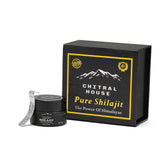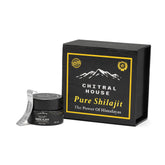Shilajit, often called “the Destroyer of Weakness” and “the Conqueror of Mountains,” is a sticky, tar-like exudate found primarily in the rocks of the Himalayas and other mountain ranges. For thousands of years, it has been revered in Ayurvedic medicine as a Rasayana—a rejuvenator and powerful adaptogen.
While it is broadly known for boosting energy and male vitality, modern research is now shining a spotlight on its profound and unique benefits specifically for women. These targeted advantages address critical phases and common health challenges in a woman’s life, from reproductive years to post-menopause.
Here is a detailed look at the lesser-known, yet immensely valuable, benefits of shilajit for women’s health.
1. The Superior Solution for Iron Deficiency Anemia
Iron deficiency anemia (IDA) is the world’s most common nutritional deficiency, and women are disproportionately affected due to menstruation. Shilajit offers a multi-faceted approach that goes beyond a simple iron supplement.
High Bioavailable Iron Content
Shilajit is naturally rich in iron and other vital minerals. Crucially, these minerals are in an ionic form, which is more readily absorbed by the body compared to many synthetic supplements.
Combating Anemia-Related Fatigue
Anemia is characterized by a lack of energy due to poor oxygen transport. Shilajit is renowned for enhancing mitochondrial function (the “powerhouses” of your cells). By improving cellular energy production, it helps counteract the deep fatigue, weakness, and lethargy that often accompany low hemoglobin levels.
Scientific Validation
Preliminary studies, though small, have demonstrated Shilajit’s ability to significantly increase levels of hemoglobin, hematocrit, and red blood cells in anemic models, supporting its traditional use for this condition.
2. A Proven Defense Against Postmenopausal Bone Loss
Bone health is a critical concern for women, especially following menopause when the protective effects of estrogen diminish, increasing the risk of osteopenia and osteoporosis.
Preservation of Bone Mineral Density (BMD)
A randomized, double-blind, placebo-controlled clinical trial on postmenopausal women with osteopenia reported that daily Shilajit supplementation helped maintain bone mineral density at the lumbar spine and femoral neck in a dose-dependent manner.
Modulation of Bone Turnover Markers
Findings suggested that Shilajit may favorably alter bone turnover by decreasing resorption markers (e.g., CTX-1) and supporting formation markers, slowing the rate of bone breakdown.
Reducing Inflammatory Damage
Post-menopause is often associated with increased systemic inflammation and oxidative stress. Shilajit’s anti-inflammatory and antioxidant properties—largely attributed to fulvic acid—help mitigate this cellular damage, offering protective effects for the skeletal system.
3. Comprehensive Support for Hormonal Balance and Fertility
Shilajit acts as an endocrine tonic, supporting the delicate hormone balance that governs everything from mood to conception.
Addressing PCOS and Metabolic Health
Polycystic Ovary Syndrome (PCOS) is commonly linked to insulin resistance. Shilajit has been reported to improve insulin sensitivity, which can help regulate blood sugar, lower the risk of weight gain, and support healthier reproductive hormone balance.
Estrogen and Progesterone Regulation
Traditional use and emerging data suggest Shilajit may help normalize female reproductive hormone levels, specifically estrogen and progesterone. This can support more regular cycles, fewer PMS symptoms, and a healthier uterine environment.
Adaptogenic Stress Management
Chronic stress elevates cortisol, disrupting endocrine signaling and menstrual regularity. As an adaptogen, Shilajit may help the body cope with stress, potentially moderating cortisol and supporting reproductive health.
4. Anti-Aging & Skin Rejuvenation from the Inside Out
The anti-aging effects of Shilajit stem from enhanced cellular and circulatory health.
Boosting Skin Microperfusion
In a study on middle-aged women, Shilajit supplementation was associated with increased skin microperfusion (blood flow), delivering more oxygen and nutrients to dermal layers for elasticity and radiance.
Cellular Regeneration and Collagen Support
With its complex of minerals and antioxidants, Shilajit supports genes involved in endothelial cell migration and growth, essential for tissue repair and maintenance of the extracellular matrix (collagen and elastin).
Powerful Antioxidant Protection: Fulvic acid is a potent antioxidant that combats free radicals—primary culprits behind cellular damage and visible signs of aging such as wrinkles and loss of firmness.
5. Enhanced Cognitive Function and Mental Resilience
“Brain fog” and cognitive slowness often accompany high-stress periods or hormonal shifts such as perimenopause. Shilajit offers neuro-supportive benefits.
Improved Memory and Focus
Traditionally used to enhance memory and learning, Shilajit’s constituents—particularly fulvic acid—are believed to support neurotransmitter activity and cerebral oxygenation, aiding focus and mental clarity.
Neuroprotective Activity
Fulvic acid has been shown in laboratory models to inhibit tau protein aggregation, a factor in age-related cognitive decline, suggesting potential for long-term brain health support.
Important Considerations for Women
To help ensure safety and efficacy, consider the following:
Choose Purified Shilajit Only: Never consume raw or unprocessed Shilajit. It should be traditionally purified (Shodhana) to remove heavy metals (e.g., lead, mercury), fungi, and other contaminants. Buy from reputable brands with third-party purity testing.
Consult a Healthcare Provider: If you are pregnant, breastfeeding, or have medical conditions (especially hormone-sensitive conditions, a history of hemochromatosis, or issues with iron overload), consult your clinician before starting supplementation.
Dosage: Clinical protocols commonly use 250–500 mg per day of purified extract. It is typically dissolved in warm water or milk. Start low and follow product guidance or a practitioner’s recommendation.








